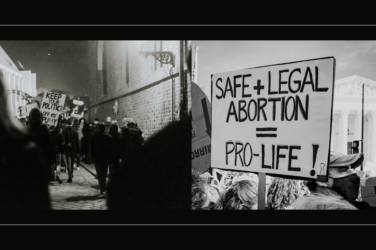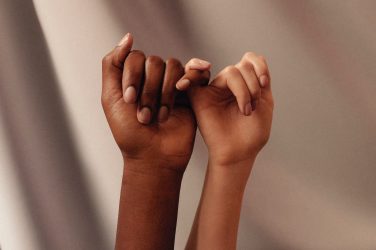
Hi Kay! To begin with, can you describe what Thandiekay is exactly, what do you write about and who contributes?
ThandieKay is inspired by a ’space’ that Thandie and I (and we believe many girls like us) wish had existed when we were younger. Thandie was born in Cornwall, where her mother was literally the only black woman in the village, married to a white man, and they were the only children of mixed heritage. So unused to African culture were they, that the nuns in her school sent her home on the day of the school photo when her Mum lovingly braided her hair to make her look special.
I, on the other hand, grew up in the cultural and social mashup that is West London, and I had friends who were posh, friends who were from an estate, friends that were West Indian, African British, Indian, Bangladeshi, Chilean, Portuguese (I could go on!). Being mixed meant that I was welcomed into many different cultural environments, but I wasn’t like them exactly, so I didn’t quite belong fully. I was an anomaly. But then everything else was unusual about me too, I was an only child (rare in the 70’s/80’s), my Mum was 41 when I was born (again, rare in the 70’s/80’s), my father passed away when I was 9, so I only had one parent, and my Mum, although she was highly functioning, was Bipolar. So being half Trinidadian was just one other thing that made me different. Growing up around so many different cultural groups informed me that people in general like forming big tribes that, given the wrong gang leader, can all gang up against a smaller tribe. I could never understand for instance, that the West Indian girls in my class (who outnumbered the African girls at the time in London) would shout out ‘tar baby’ to the African girls, all the while being supposedly proud of their black culture. I understand the contradiction more now. By shaming the African girls about their darker skin, the West Indian girls were clearly not as proud of being from the African diaspora as they made out.
Creating ThandieKay was a way of bringing out these contradictions out into the open in gentle ways, by using the easiest thing available to us: representation. Thandie is well known, and a well-known beauty. I am known in my industry for embellishing beautiful faces.
Modern society is obsessed with fame and the currency of beauty, we see this as a Trojan horse from which to get a change to challenge the status quo.
Modern society is obsessed with fame and the currency of beauty, we see this as a Trojan horse from which to get a chance to challenge the status quo and disrupt without anger, disrupt with representation, disrupt with inclusion.
We invite a variety of people to guest at ThandieKay, we come across people in a variety of ways: via social media (we’ve found many unknown women who we think say or do something unique), via friends, and it is all about bigging up each other because what the world lacks is encouragement. Thandie and I as children never felt recognised for who we really are, and via the various struggles we both had internally, we both find it incredibly healing to do that which we so desperately needed – to be encouraged and to be allowed to express ourselves in environments that provide nurturing and acceptance.
Have you noticed any improvement or degradation in the representation of women of colour in the media in the past few years?
It’s like a sporadic drip feed. I think as you get older, you become more aware of so many things that were ’normal’ to you because the society around you ’normalised’ it. So yes, from patriarchy, toxic masculinity and misogyny and everyday sexism, to homophobia and systemic racism, you start to see it more and more, but only once you become aware. All of them come from the same place, they all come from a combination of ignorance, pain, and fear.
More specifically, the “About Us” section of the website reads that “racial and gender equality are so important but it also great to know that our voice is not only the voice of protest.” Do you feel that protest is the only platform given to women of colour in the media?
I think that most voices of inequality are often only noticed via protest. In the Art, literature and entertainment world it is different of course, because these industries tend to attract people who do not fit into white, male, hetero privilege who are at the helm of the West, and attract those who accept, love, and define people of all ethnicities, genders, and sexual orientation as simply other people.
As I understand it, both you and Thandie are based in the UK – have you noticed any difference in the representation of women of colour (or lack thereof) throughout Europe? And in the world?
It is very different throughout the world, because the African diaspora has entered countries in many different, and complex ways.
I lived in NY throughout my late twenties and thirties, and I realised how much I took the lens of West London for granted. I realised that there was nowhere else in the world quite like it. I realised how un-united the states of America were. It’s much more systemically segregated. It’s simple; you just look at the history. Most black people who came to Britain, came over on the Windrush after the war, they were invited to work, and the streets were not paved in gold, and the welcome from Notting Hill and St Pauls in Bristol (the main areas of allocation) from the struggling white poor, was not unanimously felt. There were regular race riots right up until the 80’s. Overall, however, Londoners and those of Bristol integrated, and black culture became London and Bristol culture. Everyone in West London grew up going to clubs that played black, not white music. The way kids dress was directly influenced by Jamaican style, from low-slung jeans, to caps worn backwards, to gold hoop earrings and tightly tied-back hair.
In the US, I noticed that the Koreans keep with the Koreans, the white, upper-west-siders hang out with the other white, upper-west siders, and those in the hood stay in the hood. Black American got the vote, a basic human right, around the time that I was born, segregation didn’t legally end until a little before that, and still unofficially exists in pockets. The history is a lot more violent, a lot more painful, and the 13th amendment is a whole lot more dubious than laws we have in the UK. I have less idea of the rest of Europe, as I have not lived there.
On a different note, you are a make-up artist so, as an ‘insider’ of the beauty industry, do you feel that it contributes to the perpetuation of stereotypes of conformity? (be they based on gender, ethnicity, size etc.)
It can do, though it is up to you if ‘you wish to be the change’ and all that. The reality is that nothing, or very little, can be changed from the outside of an industry full of creative, self-assured voices.
Only once you have a recognised voice within an industry that you have earned the place in, and over many years, can you use your platform to change it, albeit in little ways. I am not an editor or a main shareholder in a magazine or corporate news outlet, but I am often asked about model casting for shoots where it’s about the makeup. Then of course I use that space to choose WOC when I can. I am vocal about size, and I’m often not liked for it, and that is a tougher thing to get the message to in fashion, as they understand beautiful black women, but they have a harder time seeing a bigger woman as having a beautiful body, that makes clothes that the designers make, look the way that they designed them.
Is there anything else you would like to say to our Europe&Me readers?
Find people and ideas that you are passionate about and the rest will fall into place.
Cover photo: Courtesy of Thandiekay.com





